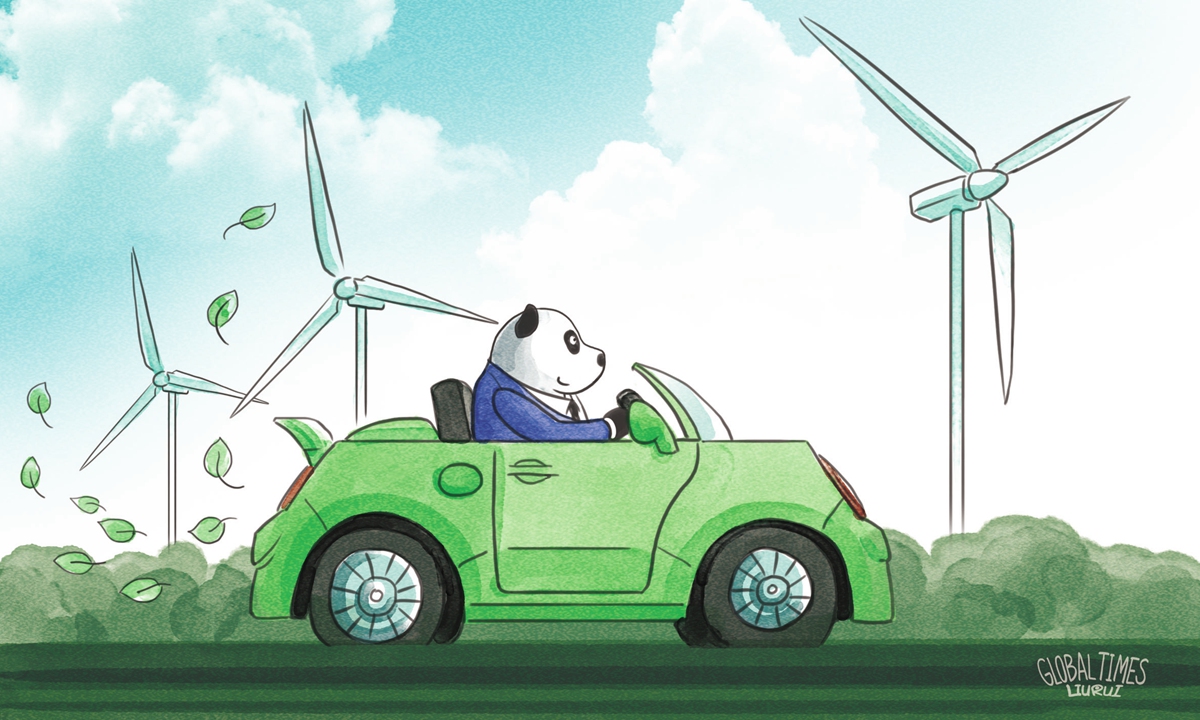
Illustration: Liu Rui/GT
During China's annual Central Economic Work Conference held at the end of 2020, reducing carbon emission was listed as one of China's eight key tasks to focus on in 2021. China has a firm determination to tackle climate change.
In September, Chinese President Xi Jinping promised to achieve carbon neutrality before 2060 at the general debate of the 75th session of the UN General Assembly, which was held by video link. After that, Chinese provinces and cities immediately began to deploy a low-carbon economy in full swing. China's task in 2021 includes formulating a plan for reducing carbon emissions by 2030. It also entails accelerating the construction of trading markets for energy and carbon emissions, improving the dual control system of energy consumption and enhancing the carbon sink capacity for ecosystems.
Martin Weitzman, professor of economics at Harvard University, once called climate change a "problem from hell." Since the 1990s, human beings have been discussing, researching and implementing policies on climate change. Finally, countries reached a historic collective consensus at the 2015 UN Climate Change Conference - limiting the rise in average global temperatures to 2 degrees Celsius by the end of the 21st century
This means that the world must quickly and comprehensively realize energy transition, including stop using coal for power by 2050 and increasing the proportion of renewable energy power supply to 85 percent. This also means that proven reserves of more than 40 percent of natural gas, 50 percent of oil, and more than 80 percent of coal will permanently remain in the earth's crust.
As the world's largest developing country, such a requirement will be quite difficult for China. A group of Chinese scholars once argued that climate change was a hoax perpetrated by the Europeans to stop China's economic growth. The idea of some Chinese conservatives is supported by the fact that China's coal power generation has long exceeded 60 percent.
However, China's policymakers and mainstream society are determined to address challenges from climate change. The Copenhagen Summit in 2009 set China's 2020 target of non-fossil energy consumption to 15 percent. It also entailed a 40 to 45 percent reduction of carbon intensity compared to 2005. The statistics for 2019 are 15.3 percent and 48.1 percent, respectively. China exceeded and fulfilled targets ahead of schedule.
Domestic conditions and demand have been the core drivers of China's positive and steady environmental progress. China's current efforts to tackle climate change do not insist on the same division of responsibilities between developing and developed countries as in the past. Nor does it link China's actions with those of other countries by any means. This has been a major endogenous change in China's climate change policy.
At present, Chinese President Xi Jinping's conviction that lucid waters and lush mountains are invaluable assets is now a consensus of the Chinese public in regards to environmental protection and climate change issues. Compared with the Trump administration's withdrawal from the Paris Agreement, Chinese people deserve more credit for their efforts.
But some Chinese people feel sad that mainstream public opinion in the West doesn't show enough respect to China's global contributions. These positive works include responses to climate change, efforts to alleviate poverty, and fighting the COVID-19 pandemic. Besides, the West doesn't recognize squarely China's financial stability and "Made in China" products are attractive in price and high in quality. Worse, the West has always been mean, prejudiced, and even hostile to Chinese people's contributions.
Fortunately, Chinese people didn't engage in wars of words. They have turned external pressure into internal dynamics. China pledges to achieve carbon dioxide emission reductions before 2030 and carbon neutrality before 2060. This has been abbreviated as the "30-60 plan" within the country. The plan has become a new focus of analysis reports by think tanks, enterprises, local governments and even security traders.
According to the China International Capital Corporation Limited, China's first joint-venture investment bank, carbon neutrality means "more economic, cleaner, and safer energy constructs." China's annual need of photovoltaic energy might increase by 70 times in the future. Its annual output value of new-energy vehicles may increase by 23 times to 1.2 trillion yuan ($180 billion). The total investment in green energy could reach an accumulated volume of 55 trillion yuan in 2060, and the annual output value of green economy will be around 10.3 trillion yuan by 2060. Accordingly, China will have stricter criteria for basic materials, accelerate large-scale farming, increase planting efficiency, and reduce the cost of transportation while pumping up its efficiency.
From the long-term perspective, carbon neutrality will push forward the strategic goal of energy reform to realize the construction of a "Beautiful China." Of course, nit-picking voices of these efforts will again become stimulus to help China advance.
China's new development pattern has been established. Chinese people in the new era should catch up with the trends and go forward boldly.
The author is professor and executive dean of Chongyang Institute for Financial Studies at Renmin University of China. wangwen2013@ruc.edu.cn




